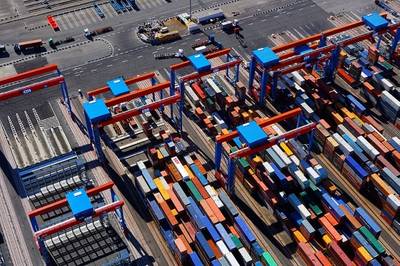Seaborne cargo throughput of 110 million tons in the first nine months sets new record for Port of Hamburg
With total throughput of around 110 million tons, the Port of Hamburg set a new record in the first nine months of 2014. Almost all throughput segments contributed to a growth of 5.7 percent. Container handling, which dominates in Hamburg as a universal port, also achieved a record mark of 7.4 million TEU (20-ft standard containers). Gaining 6.4 percent here, Hamburg is growing faster than competing ports in Northern Europe. These reported average growth of 1.9 percent in total throughput and of 4 percent for container handling. The Port of Hamburg accordingly enlarged its market share of container traffic for the period January to September from 26.1 percent to 26.7 percent.
“Hamburg is profiting especially from the double-digit growth in the container trade with Asia. With 12.8 percent growth, China particularly, Hamburg’s largest partner in the container trades, contributed to the immense boost in seaborne foreign trade for Germany’s largest universal port. The Port of Hamburg handled 2.3 million TEU containers to and from China in the first nine months of 2014. In direct container trade with Indian ports, in the first three quarters of the year Hamburg achieved a 15.4 percent advance to 176,000 TEU. Development of container trade with Malaysia during this period was also highly satisfactory, advancing by 10.2 percent to 203,000 TEU. Container trade with Africa also made excellent progress, increasing by 28.2 percent. Here it is primarily the container trades with Northern and South Africa that are ensuring steep growth,” explained Axel Mattern, a member of the Executive Board of Port of Hamburg Marketing (HHM).
Container services with the Baltic region are especially significant for the Port of Hamburg: In the first nine months of the year 1.8 million TEU were transported by feeders in this trade, representing a 2.8 percent increase. Feederships carried 300,000 TEU (+ 29.2 percent) on container services with Polish ports. “The unwavering strong growth of feeder services between Hamburg and Polish ports clearly indicates that along with Hamburg’s well developed rail and road transport services, seaborne container transport is gaining further in importance for supplying the Polish market and cannot be replaced by individual direct services to the Baltic,” said Ingo Egloff, a member of Port of Hamburg Marketing. During the first nine months, volume handled in container traffic between Hamburg and Russian ports reached around 504,000 TEU, that is 5.7 percent below the comparable figure in 2013. “After China, Russia still occupies second place among the Port of Hamburg’s container partners. For the first nine months of this year it was apparent that the weakness of the rouble, particularly, boosted the total number of loaded import containers from Russia handled via the Port of Hamburg, up by 21.9 percent at 120,000 TEU, while the figure for export containers loaded for Russia was 4 percent lower at 296,000 TEU. The total number of loaded containers in this trade therefore rose during the first three quarters to 416,000 TEU (+ 2.3 percent). “With more than 160 feeder weekly connections, 32 to Russian ports, Hamburg is further expanding its function as the central hub in the container trade for the Baltic region,” explained Ingo Egloff, a member of Port of Hamburg Marketing’s Executive Board.
Between January and September, 374 ultra-large containerships with slot capacities of over 10,000 TEU called at Hamburg. Up by 23.8 percent or almost one quarter on the comparable period of the previous year at 302, the figure for calls by ships of this size class underlines that for the sake of the port and shipping generally, the dredging and widening of the navigation channel on the Lower and Outer Elbe must be implemented. For 2015, the first registrations have been received for calls in Hamburg by ultra-large containerships of over 400 meters in length. “The Port of Hamburg remains on a successful curve. At the same time, this underlines the urgent need for the navigation channel to be dredged and widened. Today I should like to appeal to all those who care deeply about the Port of Hamburg to make it clear publicly – especially to their international business partners and port customers – that while the project cannot just yet be realized, it is more clearly than ever on course towards its objective”, said Hamburg’s Senator for Economy, Traffic and Innovation.
General cargo throughput of 78.3 million tons was the main factor behind the steep rise of 7.9 percent. An outstandingly good total for container throughput was based on strong performances on both exports, 6.6 percent higher at 3.6 million TEU, and imports, up by 6.2 percent at 3.8 million TEU. At 900,000 TEU, throughput of empty containers was slightly above the previous year’s level. Throughput in the conventional general cargo segment, 1.1 percent higher at 1.44 million tons, also developed well in the first nine months. Here it was above all exports of iron and steel, paper and timber that generated throughput growth for Hamburg’s multi-purpose terminals. At 31,600,000 tons, 0.7 percent growth was reported for the bulk cargo sector. This result was especially positively shaped by continuing strong grain exports and imports. Primarily to be viewed in connection with restructuring at a refinery located in Hamburg, a distinct 29.2 percent downturn of around 600,000 tons in crude oil imports caused a drop in volumes handled.
“2014 has in many respects been a record year for the Port of Hamburg. For us, this is both confirmation that we are on the right course with our intelligent solutions, and a motivation to keep the port on a successful course,” said Jens Meier, Hamburg Port Authority Chairman of the Board. For this year as a whole, Axel Mattern, a member of Port of Hamburg Marketing’s Executive Board, predicted: “If all goes well, in 2014 we could achieve a 3.6 percent increase in seaborne cargo throughput and one of between 3.8 and 5.1 percent on container handling.” This is conditional on further growth in container traffic with China and no further extension of the restraints on Russian trade caused by sanctions. For the Port of Hamburg, this would produce figures of around 144 million tons for cargo throughput generally, and of approximately 9.7 million TEU for container handling. That would mean topping the record mark for seaborne cargo throughput last achieved in 2008, namely of 140 million tons.
















